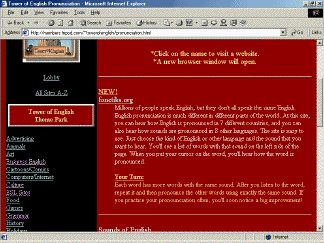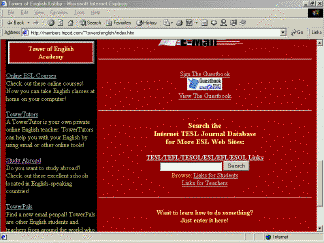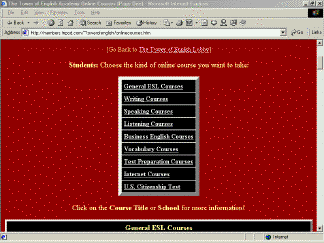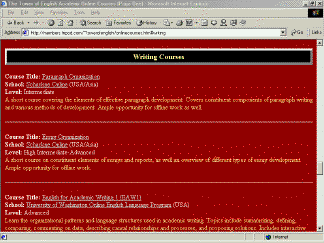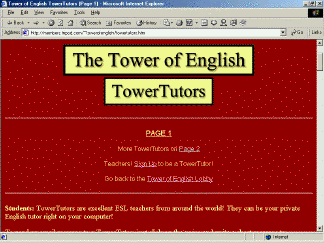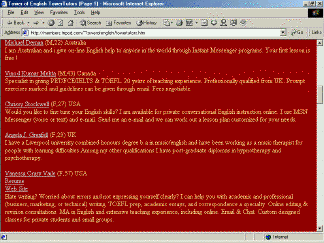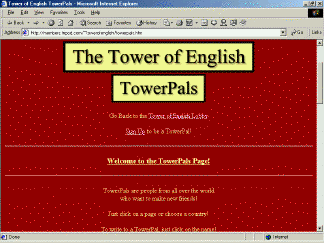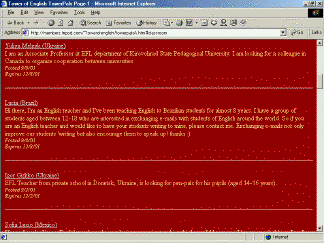September 2001 — Volume 5, Number 2
The Tower of English
http://members.tripod.com/~towerofenglish/index.html
Mentioned in a review of online reading resources by Ken Schmidt in the July 1999 TESL-EJ, the Tower of English remains “an easy-to-navigate link site.” Designed to provide ESL/EFL learners as well as TESL/TEFL instructors with a clearinghouse of links to sites presenting opportunities to “practice real English,” the TOE contains links to sites specifically designed for ESL/EFL learners and instructors as well as to those that simply contain information or content that may be of interest to this audience. The following screenshot shows the “lobby” of the TOE.
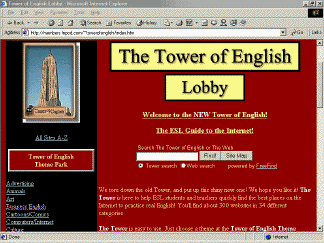
Click on any figure for a larger view
For the purposes of this review, we will look at the links to sites specifically designed for students and instructors in the areas of ESL/EFL. We begin by considering a few of the categories listed under TOE Theme Park and then look at those under TOE Academy.
TOE Theme Park
The TOE Theme Park, seen in the sidebar on the left of the screen when one enters the lobby, gives the visitor a myriad of options for finding opportunities to practice English. In addition, in most cases, when a visitor clicks on a category heading and is taken to a list of related links, he or she also finds suggestions for ways in which to use the information from the given site. The following screen shot shows what you may find if you click on the category, Pronunciation.
Other relevant links in this area include: ESL Sites, Grammar, Listening, Pronunciation, Reading, Vocabulary, Writing and Quizzes. ESL Sites actually include links not only for students, but also for instructors. Links that may interest students, in this category, range from “English On-line Reading Comprehension Project” to “ESL Study Hall.” Links of interest to teachers include: “The Internet TESL Journal,” ESL Superstore” and “About.com.”
TOE Academy
The lower portion of the sidebar contains links under the heading TOE Academy, as seen in the following screen shot.
Each of the categories under this heading leads to a set of links providing access to end sites, rather than requiring that students and teachers continue looking through more sets of links. For example, if a student clicks on the heading “ESL Courses,” they are taken to a page listing nine categories of ESL Courses, as seen in the following screen shot.
Each entry includes the course title, school name, location (where relevant), levels served and a brief description of the services provided. In effect, then, when a visitor clicks on one of the category links, Writing Courses, for example, they would be taken to a page displaying info about relevant schools and offerings, as seen below.
In addition to listings of online ESL courses, TOE Academy provides links to TowerTutors. This link takes the visitor to a listing of individuals available to provide online tutoring for students. The following screenshot shows the initial information provided when the visitor enters the TowerTutors page.
The visitor can scroll down to see the names and postings of tutors who have registered with the TOE. Tutor qualifications range from those just entering the field of ESL/EFL who are looking for teaching experience, to those who have years of experience in the field. While some links simply lead to an e-mail address for the person, others have provided links to their websites. In addition, fees seem to be negotiable for most of the tutors, depending on the type of assistance the client will be requesting. A sample population can be seen in the following screen shot.
A section is provided for instructors who wish to register as tutors with TOE. Basic contact information is requested and links to the instructor’s web site can be included.
The third category in the TOE Academy is Study Abroad. When a visitor clicks on this link, they are taken to a page from which they can search for schools depending on geographic location. The schools listed in this section of the site are advertised as “schools in English-speaking countries.” The countries currently listed are: Australia, New Zealand, United Kingdom, USA and International. The listings include the school name and location, as well as a short blurb describing the school’s service. In this section, the link opens a new browser window displaying the chosen school’s web page. A sample of schools listed is shown below.
The fourth and final section listed under the Academy is TowerPals. Tower pals are basically e-pals that meet through listings at the TOE site. When the visitor clicks on this link, they are taken to a page listing a number of options for locating a Tower pal to becoming a Tower pal. There is even a link to a section designed to connect entire classes as Tower Pal groups. The following screen shot shows the initial page from the TowerPals link.
The two basic options for finding a Tower pal are to choose from the countries of origin of pals who are listed, or, in the case of groups, to choose a link to a special section listing classes from around the world who would like to connect with other classes to set up e-pal relationships. Included in the information for each listing, for both individuals and classes, are short blurbs describing the person or group, the posting date and the expiration date of the request. The following screenshot shows sample listings from the site.
In this section, the links lead to email addresses for the people or classes listed. When last checked, most of the links were still active and expiration dates were later in 2001 or into 2002. Messages remain active for three months and can be renewed at any time.
Website design
Navigating the site is relatively straightforward. You can access the lobby from any page and moving around between the pages within each category is simple, whether you are using your browser buttons or the links provided on each page. Standard layout allows the visitor to easily predict where information will appear on each page.
The website presentation is average. Although the red background and contrasting yellow print add color to the page, they might cause eyestrain if you spend any length of time browsing the site. In addition, the use of contrasting font color and underlining for emphasis as well as for active hyperlinks is confusing at points.
Overall, the lobby area is busy, with ads at the top and spread through the lower section of the page. The basic layout, with heading and site description on the right and the navigation sidebar to the left, is standard. However, the Search area is awkwardly located in the center of the lobby area, between the heading and site description. Fortunately, in the same area, there is a link to the Site Map, which actually proves easier to navigate than does the lobby. Nevertheless, given that there is an additional Search link at the bottom of the page, allowing visitors to search the Internet TESL Journal Database, it might simplify things to put both the TOE and Internet TESL Journal Search links in the sidebar. This change would go a long way towards cleaning up the lobby area and allowing the visitor to quickly read about the site’s history and purpose.
The sidebar contains the navigation links for the site. The Academy and Theme Park, have links of obvious interest to both students and teachers. However, since the Academy links seem to be most directly relevant to the needs of both students and teachers, they might be better suited at the top of the sidebar, with the Theme Park moved to the bottom.
Content and links
Although by no means all of the links were checked during this review, due to the large quantity involved, the majority of those checked were active. In addition, the descriptions of the target sites were straightforward and in relatively easy English, making it even more accessible for nonnative speaking visitors.
In the Theme Park, for most linked sites, suggestions were provided for activities or discussions. For example, the following link, description and ideas for discussion were found under the category “Places.”
|
The Hollywood Sign [live link] Hollywood, California, is one of the most famous places in the world. It’s the place where thousands of movies have been made in the last century. One of the most famous symbols of Hollywood is the Hollywood Sign. It’s a huge sign on the top of a hill. It was built in 1923. At this site, you can read about the history of the Hollywood Sign and see some interesting pictures. (Click on TOUR to get a close look at the sign.) Your Turn:Scan the site and look for the answers to these questions: 1) What did the sign say when it was built in 1923? 2) What happened to the letter “H” in 1949? 3) Why were the letters in the sign sold in 1978? 4) Why was the sign lit up for 2 weeks in 1984? |
The addition of these questions and suggestions for activities made the Theme Park entries even more useful for students and teachers. Teachers who are looking for a site related to themes such as culture, holidays, business, etc. will find not only links, but also suggestions for using the information on the target sites. Students who are surfing the site looking for places to practice their comprehension skills will appreciate the additional guidance these types of questions provide.
In the Academy, each section provides interesting and highly relevant information for students searching for courses or programs, wanting to study abroad, or looking for e-pals to communicate with in English. However, there are a few drawbacks to each section.
In the section, ESL Courses, there are not only courses for students, but also an internet course for teachers, specifically designed to help them develop the skills necessary to establish an online presence. If one were looking for this type of information, based on the other links in this section, and the title “ESL Courses,” one would only stumble across this by accident. Perhaps a subsection titled “TESL Courses” would reduce any confusion and make it easier for instructors to find courses intended for them.
The TowerTutors section is useful for both students and instructors. Not only is it an area where students can find private tutors, but also it provides a location for teachers to set up shop as tutors. Students can search for tutors offering services that match their needs. And, teachers can use the opportunity to increase their repertoire of teaching experiences. One note, however, regarding the position of TOE in relation to the TowerTutors: at the top of the page, TOE encourages students to use the tutors, referring to them as “c excellent ESL teachers from around the world.” However, at the bottom of the tutor list, there is a disclaimer, as follows:
The Tower of English provides this page as a service to ESL students and teachers. Its only function is to post messages. It cannot attempt to verify the validity of the messages and cannot be responsible for any problems that may result from any student-teacher relationship.
Unless the students read to the bottom of the list, they may proceed under the mistaken impression that the tutors listed have undergone screening before their listing was approved. Although the tutors are no doubt quality ESL professionals, no such screening process appears to be in place.
Study Abroad contains links to several well-known and highly-respected ESL programs, but there is again no apparent screening process in place for schools listed in this section. Students should be aware that they are simply seeing a listing of schools that chose to register with the service and that the accuracy of listings are in no way certified by TOE. Finally, in this particular area, a number of links did appear to be inactive or out-of-date.
The TowerPals section is also of interest to both students and teachers. Students can locate e-pals from around the world, allowing them to practice their English and potentially learn about other areas. Teachers who would like to find e-pals for their own students can search the section for other classes who share similar goals.
Summary
Overall, the Tower of English remains an “easy-to-navigate link site.” In addition, it acts as a clearinghouse for information on courses, schools, tutors and e-pals. However, the visitor should be aware that, as on many sites of this nature, there is no screening process for services listed. Nonetheless, given its variety of links and information, TOE is definitely a site worth recommending to your students and worth visiting yourself.
Andrea Word-Allbritton
University of Alabama in Huntsville, USA
<language_training@hotmail.com>
|
© Copyright rests with authors. Please cite TESL-EJ appropriately.
Editor’s Note: Dashed numbers in square brackets indicate the end of each page for purposes of citation. |


